Zeke Faux is an investigative reporter for Bloomberg Businessweek and Bloomberg News. He is the recipient of the Gerald Loeb Award and the American Bar Association Silver Gavel Award and was a finalist for the National Magazine Awards. He, his wife and three children live in Brooklyn: September 12, 2023
This is another story that makes my blood boil after FTX: Going Infinite...
Number Go Up The core of this book revolves around Tether/USDt, and investigating this company has become the main line throughout the story. Here are some shocking discoveries I made after reading this book, which I would like to share with you.
January 2021: The story begins in the context of COVID-19
The author of this book, Zeke Faux, became extremely curious about cryptocurrency because a friend of his made $500 by investing only $10 in Dogecoin. So, while working at Bloomberg, Zeke decided to write a story about cryptocurrencies and began investigating Tether.
During the investigation, Zeke discovered that Tether has assets of up to 55 billion US dollars, which is enough to rank among the top 50 banks in the United States if calculated by bank size. However, Tether's official website shows that the company's director is actually an Italian plastic surgeon who later switched to become an electronic product importer and was even sued for selling pirated Microsoft software. This person is none other than Giancarlo Devasini, the core figure of Tether.
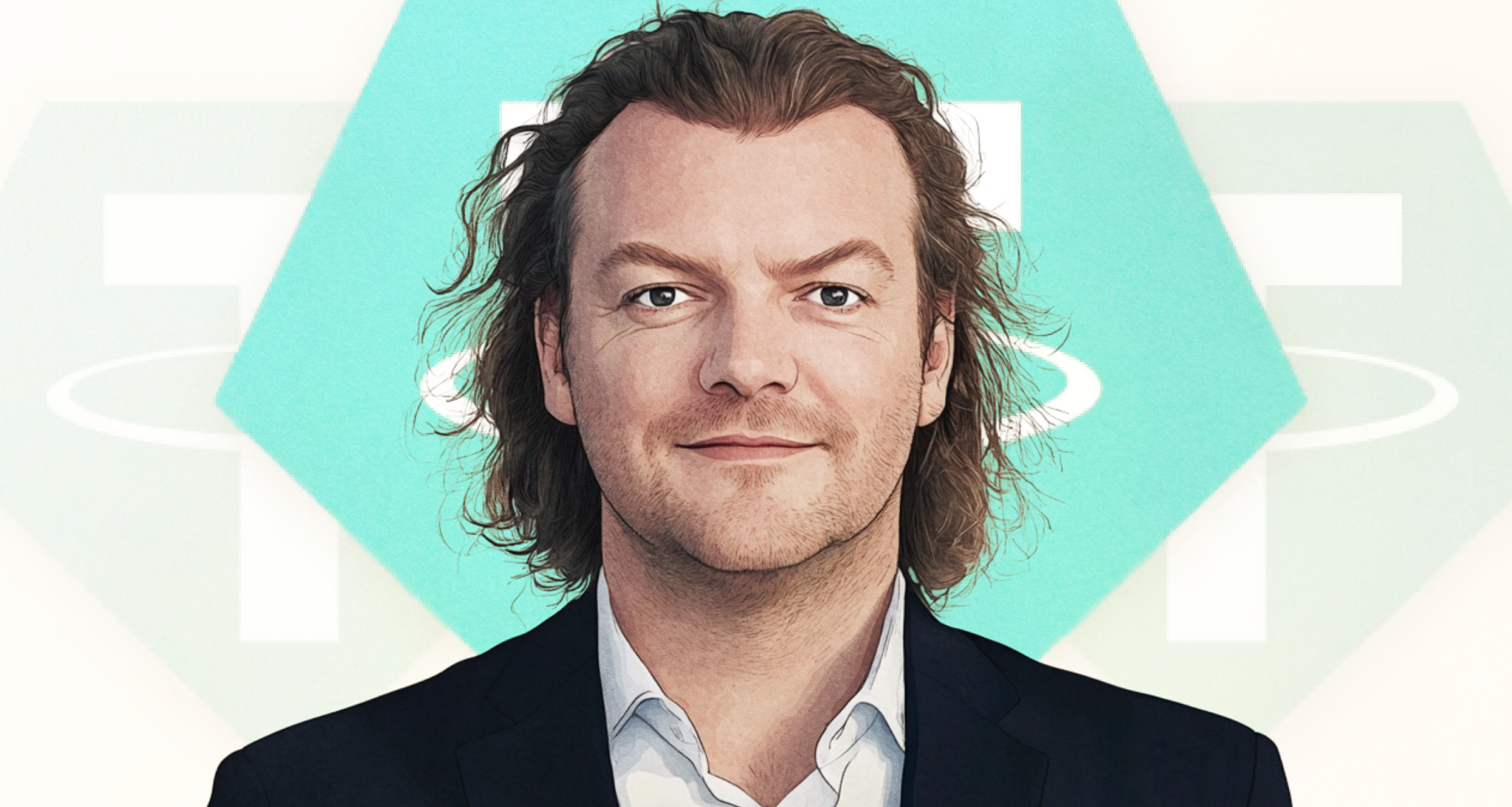
Giancarlo Devasini was born in Turin, Italy in 1964. He is richer than Piero Ferrari. He even surpasses Piero Ferrari, the vice president of the luxury sports car company and the son of Enzo Ferrari, with a net worth of about US$9.2 billion.
In June 2022 Zeke decided to fly to Miami in person to attend the Bitcoin 2021 Conference. A novelist Carl Hiaasen once described Miami like this:
“All the evil scum, corrupt politicians, and heroin dealers in the United States will gather in Miami.”
This sentence also reveals the financial backers behind Miami’s booming development.
Zeke met Brock Pierce, an early co-founder of Tether, in Miami. Brock Pierce: The concept of stablecoins was conceived as early as 2013, and it was an innovation that could change the course of history. Their original project was called Realcoin, and they collaborated with Phil Potter of offshore exchange Bitfinex, who was also developing a similar concept, to eventually name it Tether.
The most controversial point about Tether at the time was that USDt violated almost every regulation in the banking industry. At the time, other developers who proposed similar concepts were almost all arrested, such as the Electronic Token (E-Gold) proposed by Hawaii Congressman Ron Paul, who was also arrested for money laundering, but Tether escaped regulatory scrutiny at the time.
Brock Pierce decided to abandon the project because USDt had too few users in 2015. He said: "If I get sued once, I will go to jail."
However, Bitfinex was very interested in the development and business of Tether, so Phil Potter told the idea of Tether to Bitfinex boss Giancarlo Devasini, and Giancarlo immediately accepted the idea. Giancarlo then purchased the remaining shares from Brock Pierce and ultimately owned 40% of Tether.
At that time, all customers who wanted to trade with Tether would send messages directly to Giancarlo himself.
I also sent a message to Giancarlo via Telegram in February 2019, when I wanted to do an OTC (over-the-counter) transaction with Bitfinex.
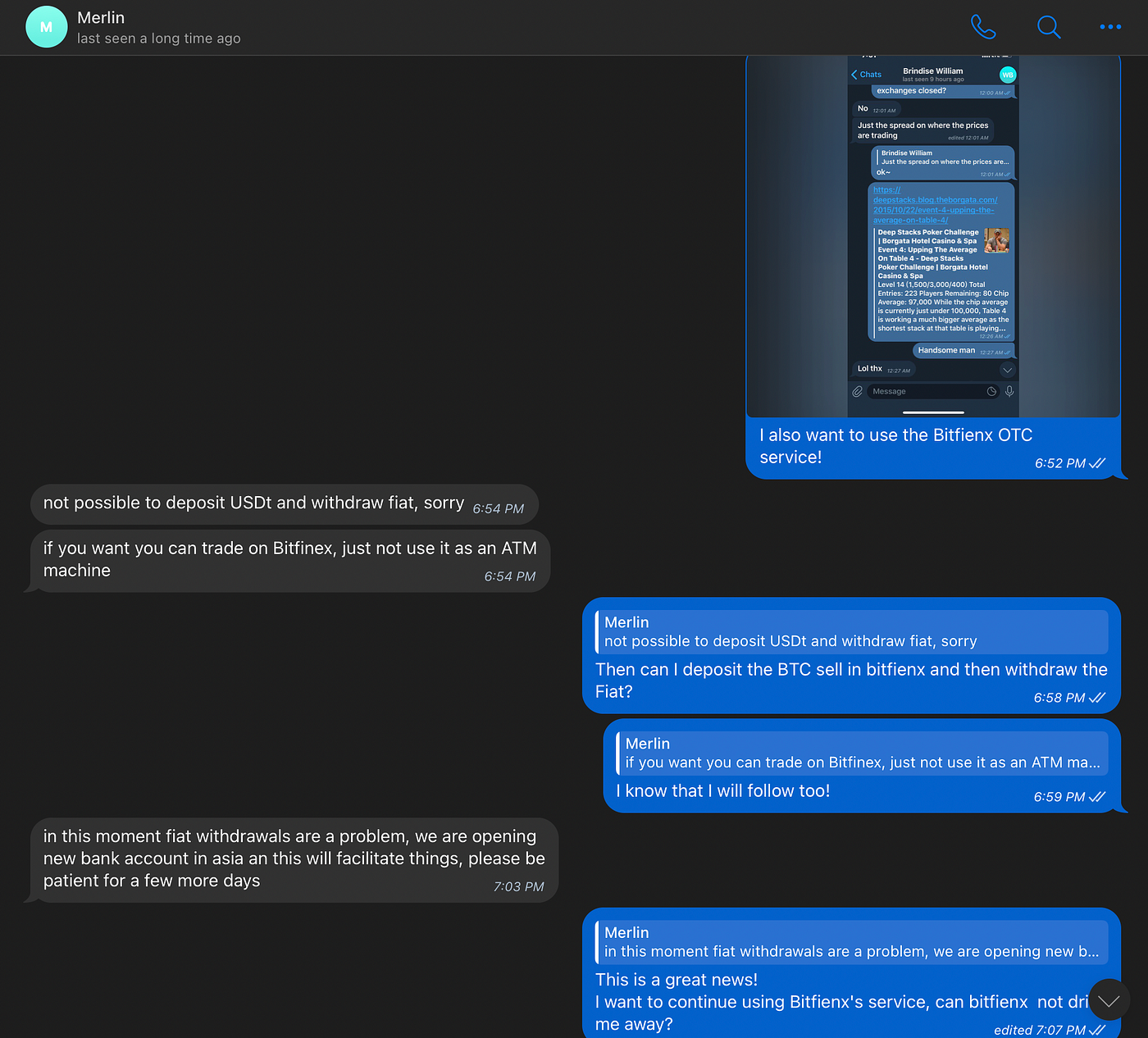
My Telegram conversation with Giancarlo Devasini back then / I used the anonymous name Merlin because Devasini looks very similar to me.
Brock Pierce finally added:
“Giancarlo Devasini has taken great personal and financial risks for the development of the cryptocurrency circle.”
Book a flight to Milan, Italy to find out
Zeke wanted to know more about Tether boss Giancarlo Devasini, so he went to Milan, Italy to find more information. : : : : : : : : : : : : : : :
Around the same time, Devasini invested in an exchange Bitfinex. The founder of Bitfinex is a young Frenchman who copied the code of Bitcoinica for development. Soon after,Devasini became the de facto head. In February 2014 Devasini responded to other customers on the Bitcointalk forum: “The transparency of our operations does not mean we need to spend time refuting meaningless accusations.”
It can be seen that Devasini’s personality is very strong, and he hates those idiots on the Internet…
Bitfinex was hacked in 2016 (the strongest money laundering robbery: the cryptocurrency thief)
The biggest trouble Bitfinex encountered was that hackers stole 119,756 bitcoins (worth about 72 million US dollars at the time), equivalent to more than half of the exchange’s cryptocurrency…If it were in the traditional financial industry, Bitfinex should have declared bankruptcy. But what Bitfinex did was to cut 36% of all customers' account balances (including those whose Bitcoins were not stolen) and then issue an IOU - BFX Token... Devasini took very tough measures and learned a lesson: "Even if he changed the rules of the game, it wouldn't matter." The ICO bubble in 2017-2018 allowed Bitfinex to quickly fill the losses stolen by hackers, and also led to a sharp increase in USDt demand. The ICO craze in 2017 brought Bitfinex a profit of $326 million, and Devasini's holdings alone were worth more than $100 million.
Initially, USDt could only be traded on Bitfinex, limiting its usability, but later Poloniex Exchange began accepting USDt transactions, and by the end of 2017, USDt's liquidity had reached $1 billion.

Netflix's new film "The Biggest Heist: Cryptocurrency Heist" (The Biggest Heist Ever)
In 2021, the cryptocurrency heist encountered Devasini, who stated that all losses had been returned to users on Bitfinex. Bitfinex considered itself the "only victim" and submitted a victim statement, which was supported by its parent company iFinex.
Devasini is eager to recover billions of dollars from this incident...
Banking pressure faced by Bitfinex/Tether
In 2017, Tether deposited funds in several banks in Taiwan (Huatai Commercial Bank, Cathay United Bank, First Commercial Bank, Taishin Bank, Kaohsiung Bank and Shin Kong Bank). Taiwanese banks need to rely on Correspondent Banks as intermediaries to transfer funds from Taiwan to customer accounts in other countries. However, these correspondent banks did not recognize cryptocurrencies and cut off services to Bitfinex one by one, with the last one being Wells Fargo, which eventually resulted in Tether funds being trapped in Taiwan and unable to be transferred overseas. Devasini even considered chartering a plane and flying the cash overseas (similar to SBF’s mindset).
What’s even more strange is that during the time when Tether filed the lawsuit, Tether still printed $200 million worth of USDt on the Omni chain (USDt was first issued on Bitcoin’s Omni Layer). At this point, Tether no longer has any operating bank accounts, so the question is: Did anyone really transfer $200 million to Tether?
A researcher named Bitfinex’ed found in court documents that Tether itself admitted that it had no access to the banking system. Bitfinex’ed further researched the lawsuit between Tether and Wells Fargo and was surprised to find that Tether is not backed by any bank or cash at all...
Zeke the author contacted Bitfinex’ed and met with him in Miami Beach. : : : : : : : : : : : : : : : Zeke contacted the bank's founder John Betts, but in 2018, Tether fell out with Noble Bank International because Devasini insisted on investing customer funds in yielding bonds to increase the company's revenue, but John Betts refused because this would increase the risk of customer funds.
Devasini directly stated: "We need to use customer funds to invest in bonds. We need more income and do not need to respond to critics."
Tether's business model itself has a conflict of interest. Any investment income belongs to Devasini and shareholders, but any losses are borne by USDt holders. If Tether incurs investment losses, it is more likely to conceal the facts rather than disclose them proactively, which would lead to bank run risk.
After Devasini withdrew the funds from Noble Bank International, the bank collapsed shortly afterwards…
The bank run storm still came…
Bitfinex has been using Panama-based remittance service provider Crypto Capital to transfer funds and deposit part of the funds.
However, Crypto Capital President Ivan Manuel Molina Lee maintained a deposit account for Bitfinex at a bank (Bank Spółdzielczy) in the Polish town of Skierniewice, but the funds were eventually used for money laundering.
In the summer of 2018, Bitfinex deposited $1 billion in Crypto Capital, but Crypto Capital suddenly suspended withdrawals for Bitfinex customers. : : : : : : : : : : : : : : :
At that time, I also tried to withdraw US dollars from Bitfinex, but the bank transfer remittance addresses I received were all messy company numbers. Bitfinex executives and employees used their own bank accounts to transfer funds to Bitfinex customers' bank accounts to cope with withdrawal pressure.
In 2019, New York Attorney General John Castiglione began investigating Bitfinex and was shocked to find that Bitfinex had more than $850 million in funds stuck in Crypto Capital and that Bitfinex had secretly misappropriated Tether’s reserves to fill the funding gap of Bitfinex’s customers.
At that time, USDt did not actually have a 1:1 US dollar reserve. After the incident was exposed, Tether immediately deleted the "1:1 US dollar reserve" statement on its official website. This is ridiculous!
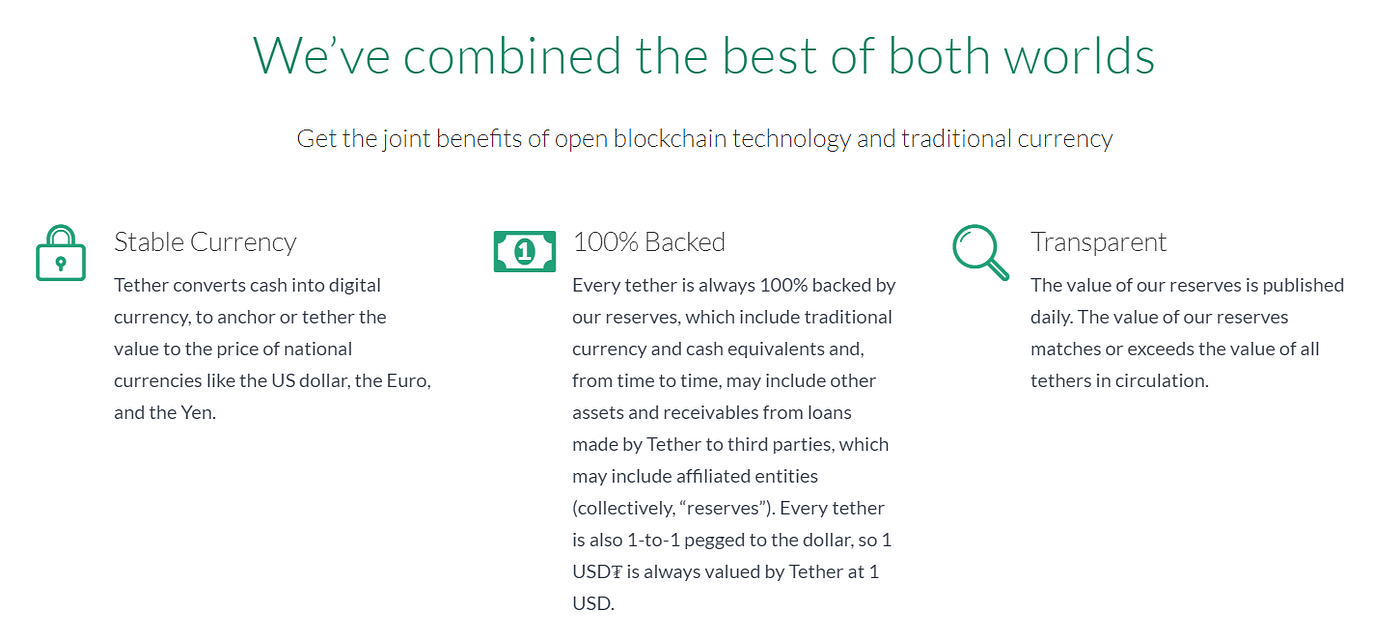
Tether's changes to its website at the time raised new concerns about the company's reserve policy
When John Castiglione reviewed the fund transfers between Bitfinex and Tether, he tried to find out who was responsible for approving the flow of funds... It turned out that the person who agreed to Tether to provide Bitfinex with a $900 million credit line was Giancarlo Devasini.
When the incident broke out in 2019, the market began to panic. How does Giancarlo Devasini fill this $900 million funding gap? Since we can’t continue to print USDt out of thin air, let’s just issue our own platform coin (Unus Sed Leo, LEO)! Bitfinex quickly raised about $1 billion through LEO, all of which were sold to cryptocurrency giants at the time, including Alameda Research, EOS Foundation, etc.
When I discussed the LEO presale with Devasini, the minimum subscription threshold was at least $1 million worth of LEO tokens.

2019, my conversation with Giancarlo Devasini
In February 2021, Tether agreed to pay $18.5 million to settle with New York State. In October 2021, the U.S. Commodity Futures Trading Commission (CFTC) fined Tether $42.5 million.
Brock Pierce said: “Tether/USDt is covering up a huge lie, and many people believe that Tether/USDt is the last hope of the crypto industry.”
Buying a luxury home in the Bahamas
In the summer of 2021, Zeke successfully contacted Jean Chalopin, chairman of Deltec Bank & Trust Limited. Jean Chalopin and Giancarlo Devasini are from the same town in Italy, where they are called Cugion (Italian: cousins).
Tether funds ($15 billion) are stored in Deltec Bank, and Devasini decided to buy a villa next to Jean Chalopin's Bahamas mansion as a sign of trust between business partners.
Zeke tried to find big Tether users. At that time, SBF, the founder of FTX exchange, was the main trader of Tether. SBF stated: Tether has always remained extremely mysterious. At that time, SBF purchased USDt from Tether through wire transfer, and then exchanged it back to US dollars through Tether. SBF said: "Tether's wire transfer path usually passes through three different jurisdictions and transfers funds through multiple intermediaries in the banking system." SBF shook his feet and said: "Tether may have 90% cash reserves, but in the financial market, even if you sell all your assets, the market may not be able to pay for it all..." SBF doesn't care whether USDt is a huge scam or not. He only cares about: Are there more gamblers entering FTX every day? Is FTX trading leverage increasing? In SBF's eyes, Binance is the ultimate rival in the cryptocurrency world. At that time, competition among perpetual contract exchanges was extremely fierce, and all perpetual contracts on the market were priced in USDt. Zeke continued to interview SBF, while SBF just stared at six screens with his feet up...
Promising 18% annual interest, isn't this a scam?
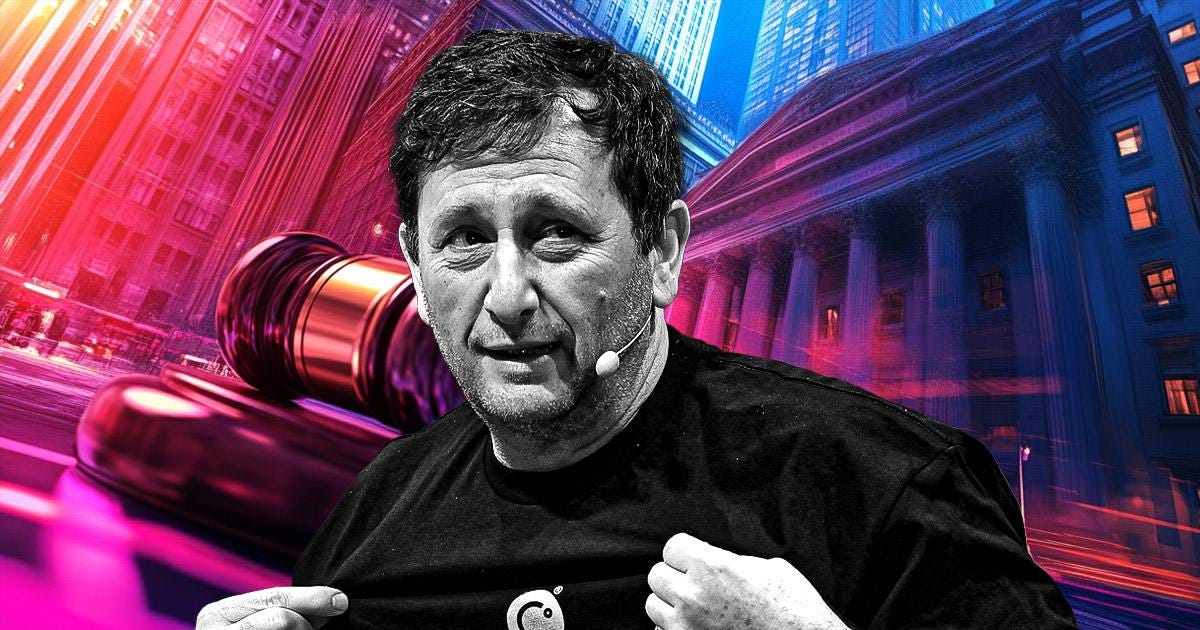
Celsius Network CEO Alex Mashinsky
Zeke suddenly received a dramatic turn. Tether had provided Celsius with a $1 billion USDt loan, but required Celsius to provide over-collateralization, that is, $1 USDt required $1.5 of Bitcoin as collateral. Even more shockingly, Tether even invested directly in Celsius, a company that later went bankrupt.
How does Celsius earn 18% interest for users?
Celsius CEO Alexander Mashinsky is a complete layman in virtual currency. His DeFi business is run by Jason Stone, who promises users an annual interest rate of 18%. While smoking marijuana and managing $1 billion in funds, Jason Stone explained to Zeke that the first DeFi platform he invested in was CREAM Finance - yes, it was Huang Licheng's (Maji's eldest brother) CREAM Finance, which had been hacked at least three times, which was ridiculous...
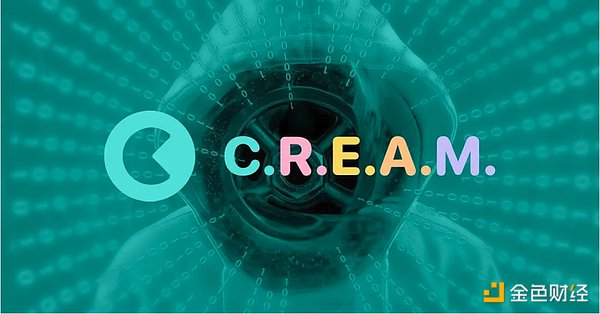
Cream Finance is valued at more than $18 million.
Jason Stone-managed Celsius continued to accumulate 18% debt and finally filed for bankruptcy on July 13, 2022.
Before bankruptcy, Celsius sought financial assistance from its largest investor Tether, but Giancarlo Devasini cold-bloodedly refused and even demanded repayment of outstanding loans from Celsius. Tether eventually used $150 million in Bitcoin and other collateral to ensure that Tether would not be affected by Celsius' bankruptcy before Christmas 2022. : : : : : : : : : : : : : : : Fang Junzhe had almost no weight when he was CEO because he still had to obey the real boss, Giancarlo Devasini.
When Zeke was about to meet with Fang Junzhe in the Bahamas to chat, Jean Chalopin sent a text message to Zeke, describing it as "imagine them as animals that have been brutally beaten and injured. You need to approach them slowly and don't scare Fang Junzhe."
After all the hard work, Zeke finally got closer to the answer to the mystery of Tether and was going to meet with the Bitfinex CEO to have a chat. They were in an empty bar at a Bahamas resort. Fang Junzhe ordered a glass of sparkling water and folded his glasses and put them in the glasses case.
Opening remarks! : : : : : : : : : : : : : : : He turned around, pointed at the young people at the Bahamas party, and said, "Those young people only think about making their first million and then buying a Ferrari... It makes me sad when I think about it..." He shook his head and sighed.
But he continued to assure Zeke that Tether was safe without providing any additional evidence. Zeke told Fang Junzhe that he wanted to talk to Giancarlo Devasini... Fang Junzhe turned away and said, "I don't think Giancarlo Devasini wants to meet with you."
Giancarlo Devasini finally showed up at his girlfriend's art exhibition in Switzerland.
Giancarlo Devasini has always had a much younger artist girlfriend, Valentina Picozzi. Her works are full of topics about inflation, Bitcoin and the US dollar. The "Satoshi Nakamoto" statue in Lugano, Switzerland is her artistic creation. : : : : : : : : : : : : : : :
Zeke decided to fly to Lugano, Switzerland to explore the mystery of Devasini. At noon, 58-year-old Devasini finally showed up at the art exhibition. He was tall and dressed like an old rock musician, but he was followed by two dark and muscular men - these two men from New York were instructed "not to talk to anyone"... Yes, they were Devasini's bodyguards!
Zeke had been chasing Devasini for several years and finally met him in person. Of course he rushed forward, but was stopped by the bodyguard...Devasini said in English with an Italian accent: "I wish your book will sell well."
Zeke was ultimately unable to have a face-to-face chat with Devasini about the mysterious company Tether/USDt, nor was he able to delve into his plastic surgery career, his divorce experience, or discuss the content of his past blogs, let alone dig into the inside story of Tether's reserve funds. What Zeke wanted to tell Devasini most was that USDt was used for money laundering, drug trafficking, fraud, and even human trafficking in Cambodia and Southeast Asia... I wonder if Devasini understands the role USDt plays in different corners of the world... Zeke still didn't give up. He sent a message to Devasini via Telegram: "I want to hear your story, it's very important. I'll be waiting for you at Bar Laura near the venue..." At 12:38 midnight, Devasini still didn't show up... Zeke was lying on the bed, full of disappointment, when he received a message from Devasini: "Bees don’t waste their time explaining to flies that honey is better than shit..." Giancarlo Devasini was planning something bigger.
On November 16, 2022, a few days after FTX collapsed, Devasini appeared in El Salvador and took a photo with President Nayib Bukele because he was working with El Salvador on a plan to issue $1 billion in “Bitcoin Bonds/Volcano Bonds”.

NayibBukele (sixth from left) Giancarlo Devasini (fifth from left) Paolo Ardoino (seventh from left) Max Keiser (first from left) Valentina Picozzi (third from left) Stacy Herbert (fourth from left)
Devasini certainly has reason to be so happy. In 2022, the Federal Reserve continued to raise interest rates to fight inflation, and by December, the interest rate had risen to 4%. Tether does not have to pay interest to USDt holders, and all the income generated by the large amount of US Treasury bonds held by Tether flows into Devasini's pocket, which is almost pure profit! : : : : : : : : : : : : : : :
US Government
1. The US government needs to maintain the huge lie of the US dollar, and Tether plays a very important role, allowing USDt to circulate in developing countries (Vietnam, Cambodia, Thailand, El Salvador, etc.), so that the lie of the US dollar can continue...
2. Tether holds up to US$113 billion of US Treasury bonds, which is exactly what the US government is happy to see.
Cryptocurrency Market (Crypto)
1. High-leverage exchanges such as Binance, FTX, and Bybit all rely on a large amount of USDt as transaction settlement units.
2. The DeFi ecosystem also relies on USDt as infrastructure to build more protocols on top of it.
Southeast Asian Scams
A large number of telecommunications frauds in Southeast Asia rely on USDt for fund transfers, including money laundering, drug trafficking, fraud, human trafficking and so on. Many people who want to hide their assets and evade taxes also like to use USDt because it can quickly transfer funds and can be easily exchanged for fiat currencies in other countries through OTC transactions in Southeast Asia.
In the world of Web3, only US dollar stablecoin is needed, and stablecoins from other countries are not needed
In the future Internet world, no matter which country you come from, everyone will only use "US dollar stablecoin USD Stablecoin".
People are not used to using RMB, Euro, Yen for settlement. Judging from Tether’s data, CNHt, EURt, and MXNt trading liquidity is extremely low, which speaks volumes.
It's like the richest people in the world only buy real estate in Manhattan, New York because the transaction liquidity there is large, the market is mature, and it has global indicator significance. Real estate in other countries basically belongs only to the local people.

Tether official website USDt CNHt EURt MXNt total issuance quantity
The Taiwan market does not need a cryptocurrency exchange at all, USDt is enough!
You will find that in Taiwan's cryptocurrency exchanges, the largest trading volume is always USDt/TWD.
As long as you have USDt, you can freely buy and sell various cryptocurrencies on offshore exchanges. Regardless of the type of transaction, USDt has the best liquidity and depth.
Tether (USDt) can be said to be a game-changing innovation that has completely overturned the business model of many people.
Is Giancarlo Devasini saving the industry or satisfying his own desires?
My answer is: Desire...
The rest is up to you who are using USDt to imagine...
 Weatherly
Weatherly











